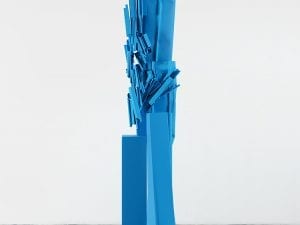Curator Philipp Kaiser transforms the Pavilion of Switzerland into an exhibition titled, Women of Venice. Open within the grounds of the Giardini della Biennale, the presentation explores Alberto Giacometti’s absence in the history of the Swiss Pavilion through a selection of new work by Carol Bove and Teresa Hubbard / Alexander Birchler. Responding to the fact that Giacometti declined all requests to exhibit work at the Venice Biennale, the three artists provide audiences with a chance to learn about his oeuvre with fresh eyes. Named after the artist’s only appearance at the Biennale, in the French Pavilion’s 1956 show Femme de Venise, it explores concepts of national identity and cultural policy.
As one of the most influential Swiss artists of the 20th century, Giacometti’s absence from the country’s Pavilion is surprising. From an early age, he saw himself as an international artist and refused to be defined through a national identity. Even when his brother, the architect Bruno Giacometti, built the new Swiss Pavilion in 1952 and the artist was asked to show there, he turned the invitation down and suggested another artist instead. As a form of international recognition for his practice, he was awarded the Grand Prix for Sculpture in Venice in 1962, a few years before his death.
Teresa Hubbard / Alexander Birchler’s film installation Flora fills part of the Pavilion. The piece weaves together extensive research with fictional and documentary material in order to reconstruct and re-imagine the life and work of Giacometti’s first great love, the largely unknown American artist Flora Mayo, who also studied in Paris in the 1920s. The creative duo and American-Swiss couple Hubbard and Birchler draw on their own relationship and collaborative artistic activity for inspiration, while shedding new light on Giacometti’s early life.
Carol Bove accompanies the duo with an enquiry into the essence of sculpture. For the Swiss Pavilion, she takes Giacometti’s figurative constellations as a starting point, raising issues of theatricality and autonomy within the discipline. In response to Giacometti’s absence, Bove creates a new group of seven powder-blue sculptures presented in the courtyard of the Pavilion referring to the artist’s late figurative work. Interested in the verticality and physicality of Giacometti’s figures, her pieces engage sculptural vocabularies through both material specificity and eclecticism. In conversation with these are two additional sculptures by Bove which address the notion of presence in correspondence with their architectural surroundings.
Women of Venice: Carol Bove and Teresa Hubbard / Alexander Birchler, Swiss Arts Council Pro Helvetia, Pavilion of Switzerland, until 26 November, Giardini della Biennale, Venice.
For more: www.prohelvetia.ch/en/2016/09/women-of-venice.
For the latest news in contemporary art and culture, follow us on Facebook, Twitter and Instagram.
Credits
1. Carol Bove, First Blue Column (detail), 2016. Courtesy of the artist and David Zwirner.





